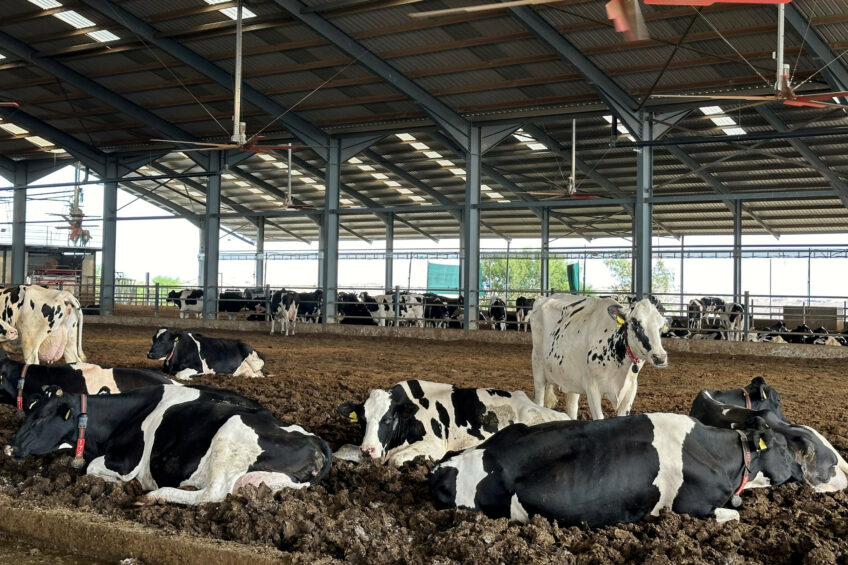Monitoring animal welfare in dairy

The common agricultural policy (CAP) is set to manage the transition towards a sustainable food system and strengthen the efforts of European farmers to contribute to the EU’s sustainable objectives. EU countries set eco-schemes in their CAP Strategic Plans as key tools to deliver the Green Deal targets. Such agricultural practices focus on meeting conditions related to climate, environment, animal welfare and antimicrobial resistance.
SUSTAINABILITY & WELFARE SPECIAL 2024 – read all articles
Market demands are reshaping the dairy-farming industry and force farmers and livestock keepers globally to remain economically viable under competition offcuts while producing products under ethical manners and Animal Welfare Protocol Standards (A.W.P.S). Dairy cows are recognised as sentient beings and their welfare remains a subject for researchers focusing on disease prevention, veterinary treatment, proper housing and nutritional management conditions, expressing normal behaviour and physiology. A.W.P.S can be described by the basic five freedoms, freedom from pain – injury, diseases, physical and thermal discomfort, fear and distress as well as freedom from hunger, thirst and malnutrition. Farmers rely on their practical experience and day-to-day learning to determine how their animals can optimally produce in line with the A.W.P.S. This can, of course, come in contrast with market instability measures and volatile pricing of feed raw materials, which they relate in turn significantly to production costs. Even though farms cannot really control such costs, rather than adapting to it, Animal Science (A.S) provides knowledge towards developing positive productivity KPIs. In parallel with tremendous progress on (re)productivity measures, A.S industry must focus more on substantially improving Animal Health and Welfare (A.H.W). A.H.W considered crucial for the financial viability of a farming enterprise but also for the demand on animal-sourced foods.
Ways to monitor animal health and welfare
Although pasture-based farming offers greater behavioural freedom to dairy cows, there is an increasing global interest in the use of continuous housing systems offering greater control and management of almost all parameters associated with A.H.W. Monitoring and recording such parameters comprise overall herd welfare-positive management practices as well as health and nutritional status.
- Bedding – resting time, adequate shelter and basal stress factors
Farm design and breeding system can protect and/or expose cows to adverse climatic conditions (cold and/or heat). Climatic conditions are potentially threatening to welfare due to metabolic dysfunctions and reduced lying-resting time; the latter is known to invoking cows` stress response. Stress factors as such, involves activation of the hypothalamic-pituitary gland-adrenal axis to elevate cortisol levels, challenge of corticotrophin releasing hormone (CRH) and down-regulation of pituitary gland. Breeding temperatures and humidity (THI index) but also direct exposure to sunlight may alter heat stress conditions, cardiovascular health, respiration rate, electrolyte balance, vitamin D synthesis and lower blood pressure. Farm design and space allocation on per-head basis is of utmost importance for controlling adequate and spacious access to water and feeding stall. For young-stock and first calving heifers which are continuously housed, colostrum management, pneumonia, diarrhoea control and proper growth rate are critical parameters defining welfare and lifetime productivity.
- Nutritional management and welfare monitoring practices
Observing cows individually and on a herd level in combination with key monitoring parameters and other indexes, ensure best welfare practice. There is no doubt that there is primarily a direct and indirect relation of digestive disorders with nutrient’s balance and normal cow’s metabolic functions. The lack of energy and key driver nutrients whilst in high demand within production cycle often involves additional dysfunctions, including abnormal ovarian function, uterine diseases and calving interval, hoof and udder health issues, and a down-grade of milk quantity and quality (total solids and somatic cells). Apart from cow’s Income Over Service Life Cost (IOSLC), an individual measure of profitability (or loss) per cow at culling time, crucial monitoring parameters and indexes are directly linked with productivity and health such as Rumen Fill Score (RFC), Body Condition Score (BCS), Locomotion Score (LS). Scoring is categorised in stages 1-5 and led by experience and overall herd management and nutritional status by nutritionists and industry consultants.
RFS and BCS loss and/or gain related to dietary inputs and energy to protein to fibre to fat correct dietary supply balance. Fat cows at calving appear to have reduced feed intake in early lactation leading to higher Negative Energy Balance (NEB) and increased tissue nutrients mobilisation resulting to BCS losses. The greater the NEB the greater BCS loss, the lower the RFS will appear. Poor transition cow management is a principal risk period associated with lack of meeting many nutrient requirements, and a period when NEB is of utmost importance. This period in theory refers to the last 21st days pre- and first 21st days post-partum. In practice and depending on the herd size and feeding method, most of the times precise transition cow group allocation is not well applicable. This is even more critical from a nutrients point of view, because close-up cows (21st days pre-partum) and fresh cows (21st post-partum) require almost individual treatment and specific nutrient profile demand; whilst some of those nutrients must not be fed Vise-versa considering functionality and cost to benefit ratio.
Because of anatomophysiological changes during transition period cows appear clinical (acute) or sub-clinical metabolic abnormalities such as hypocalcaemia, ketosis, mastitis, lameness and reproductive issues RFS and normal BCS remains crucial to avoiding acute ruminal and abomasal displacement (DA). Subclinical ruminal acidosis (S.A.R.A) should be considered as the highest risk possible, as it mostly goes unnoticed by farm owner-managers if BCS and RFS not questioned with other indirect indexes of the herd. Indirectly, milk data and indexes such as fat to protein index, total milk solids, urea nitrogen can match the puzzle of proper rumen functionality. Other indexes associated with NEB are blood biochemical metabolites such as non-esterified fatty acids (N.E.F.A), β-hydroxybutyrate, triglyceride and AST (liver enzyme), pre/postpartum. Of course, additional blood biochemical metabolites such as Calcium (Ca), Phosphorus (P), Magnesium (Mg), Glucose and pH can well describe the nutrient status of individual cows.
Another key welfare indicator linked with reduced fertility – especially for cows on first phase lactation – is Sub-clinical and Clinical Mastitis. Intensive farming may lead to higher intramammary infections due to higher exposure in environmental pathogens and increased risk of high somatic cell count (SCC). SCC associated with lower enzymatic activity due to primary deficiencies of Vitamin E and Selenium, Zinc and Manganese due to antioxidant activity and numerous co-factoring enzymatic functions amongst most critical the Superoxide-Dismutase (SOD).
Calving ease is critical parameter for welfare because difficult calving and twinning predispose retained placenta, metritis and mastitis. Key welfare indexes may well describe the dynamic axis relationship between behavioural, nutritional and hormone regulating adaptations which are directly influencing reproductivity efficiencies and herd financials. Calving-conception interval (CCI) which is the average time in days from calving to successful insemination (or Days Open, the interval from calving to pregnancy), and Pregnancy Rate (PR% – measurement of fertility) are the key indicators. The lower the CCI, the higher the PR is. PR takes into consideration Conception Rate (CR – the % of animals serviced which become pregnant), meaning the cow’s ability to conceive, and is measured separately for heifers (HCR) and cows (CCR). The difference between CR and PR is that PR (heat detection rate multiplies with CR%) is influenced by heat detection related to individual herd management practices, rather than genetics. Research shows a direct relationship of nutrition and NEB with subclinical endometritis especially during fresh cow management, leading to reduced fertility. While dietary protein has limited influence as such, high in starch and fat rations increase insulin secretion and resumption of cyclicity but reduce oocyte and embryo viability. Infertility is driven by metritis by altering the ovarian function, cycle and oocyte competence.
Lameness remains a major health and welfare index as lame cows face extreme pain, discomfort and they are more likely to reduce feed intake rumen mobility. Studies showed that up to 60% of in-house breed cows appeared to be clinically lame with cases being significant over 180 days post calving. Skin lesions (hock and knee) is also an indicator of welfare with studies showing a positive relation between skin lesions and lameness. Other housing and hygienic factors may support bacterial infections and dysfunctions of the horn-producing claw epithelium leading to sole ulceration. This is why lame scoring and trimming individual cows to observe thickness of digital cushion of the claw, as preventive strategy twice a year is important. Infertility and Lameness are the biggest reasons of premature culling rates in the modern dairy operations not financially desirable.
Responsible use of antimicrobials
Dairy enterprises are increasingly challenged to meet financial profitability gains as to date, profit margins in dairy farming continue to squeeze as production costs rise faster than milk prices. On the other hand, A.H.W is becoming an important issue for dairy consumers and citizens and pressure in global dairy industry is more and more viable. EU legislation and CAP as key strategic policy leaders should continuously emphasise on farm practices for responsible use of antimicrobials resulting to cumulative global reduction, but also setting the primary conditions related to climate and environmentally friendly policies in a practical, achievable and rather financially applicable way for farmers as individuals and industry itself.
References are available on request.







